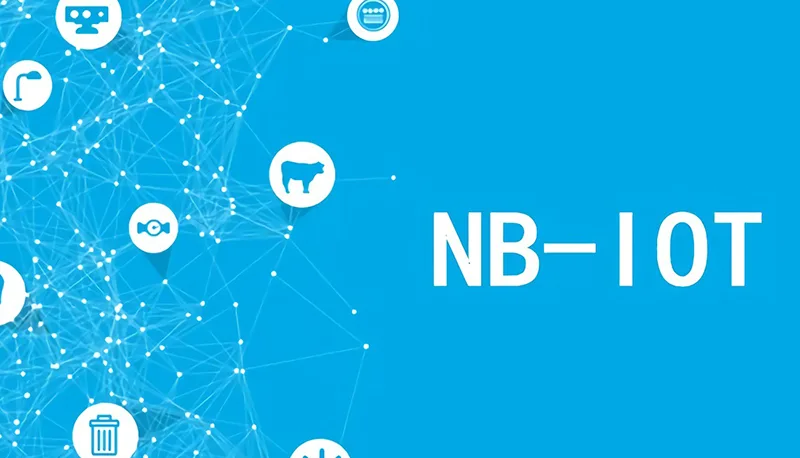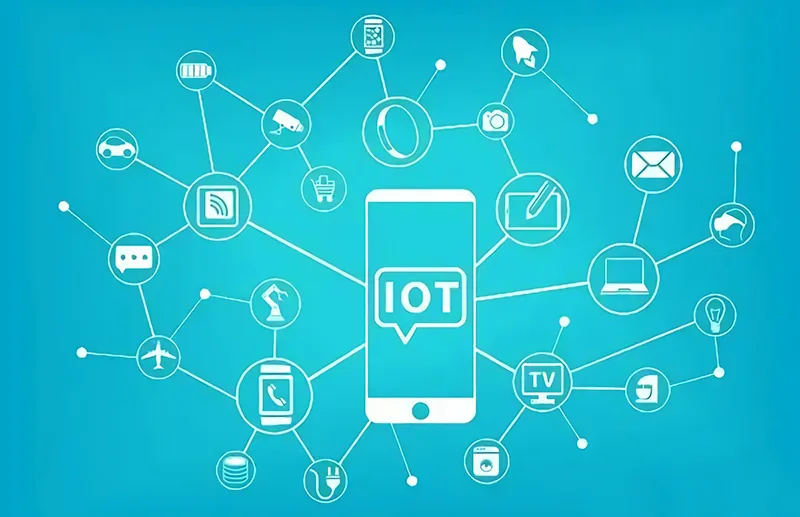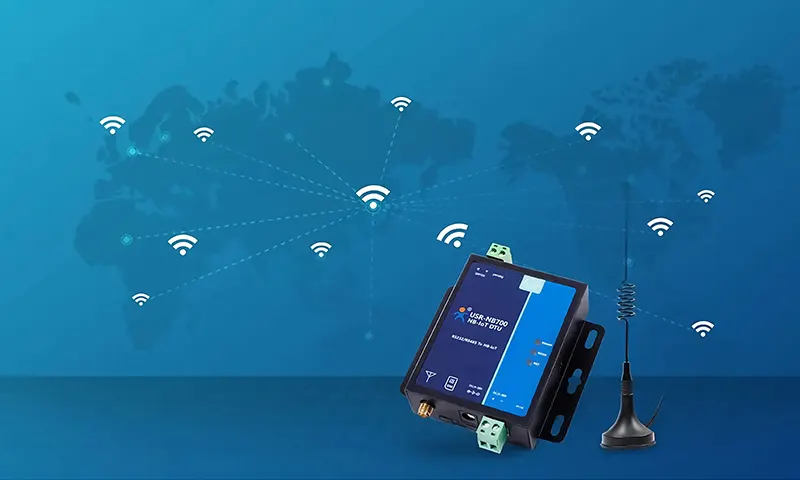節省實施成本,方便升級, 基於蜂窩網路的NB-IoT應用, 可以直接執行 全球行動通訊系統, 通用行動通訊系統, 或 LTE 網絡,僅使用約 180KHz 頻寬. 這 萬物互聯 很大程度上依賴基於蜂窩的 窄頻物聯網 (窄帶物聯網).
1. 什麼是NB-IoT技術

窄帶物聯網, 也稱為低功耗廣域網, 是物聯網領域的一項新技術,允許低功耗設備跨裝置連接到蜂窩數據 廣域網路 (低功耗廣域網). 除了提供廣泛的內部蜂窩數據連接覆蓋範圍, 預計 NB-IoT 設備的電池壽命將至少提高 10 年. 使用 NB-IoT 可以有效連接需要高網路連線速度和較長待機時間的設備.
智慧鎖, 智慧城市, 智慧水錶, 智慧瓦斯表, 智慧追蹤器, 智慧儲存, 和智慧路燈是目前NB-IoT的一些應用場景. 他們都要求平台接收原始數據. 雲端平台透過NB模組實現數據集成,並將數據交付給人們進行高效的數據分析和利用.
2. NB-IoT如何實現 工作?

NB-IoT 在嘈雜環境和低訊號水平下運作的能力至關重要, 它能夠節省電池壽命. 另外, NB-IoT旨在發送簡短訊息,不需要傳輸視聽資料, 龐大的文件, 或其他類型的內容.
在這種方法中, 一些物理特徵有助於提供基本特徵:
- NB-整體最大寬度 物聯網頻段為1個RB, 180 千赫;
- 用戶設備的無線電路徑有一個發射機, 接收者, 和天線;
- 發送和接收發生在不同的時間, 這本質上是半雙工傳輸;
- UL 方向子載波上的傳輸能力;
- 僅使用 BPSK 和 QPSK 作為調變類型;
- 廣播訊號的持續改善 (覆蓋範圍增強).
您可以簡化設備並藉助半雙工傳輸模式來使用它, 天線, 和 RB 中的窄帶. 其他事情包括;
- 減少CPU使用的功率;
- 減少能源消耗;
- 尺寸縮小;
- 更便宜的機械;
- 無線電頻率分佈:
提供 窄帶物聯網 具有頻率資源. 幾乎所有頻段與 2G 相同, 3G, 「低」欄中的 4G 可用於 NB-IoT. B3 (900兆赫茲), B8 (800兆赫茲), 和B20 (800兆赫茲) (1800兆赫茲). 由於訊號衰減很大,使用「更高」的頻率是沒有意義的.
3. NB-IoT 的用途和 NB-IoT 應用

智慧城市
長電池壽命和最低價格是NB-IoT的目標. 適用於非行動裝置, 數據量低, 延遲不敏感, 對成本敏感的, 以及非常大的終端數量級應用. 智慧電錶, 智慧路燈, 維修孔蓋等智慧智慧城市應用的特點是數量, 分佈廣泛, 流動性弱, 定位精度對定位時效性不敏感,也是日常的. 因此, 由於終端數量非常多,速率和時延容忍度更高. 進行日常終端維護通常具有挑戰性, 有必要維護終端的放置和運作狀態, 使 NB-IoT 定位非常適合.
智慧農業
考慮畜牧業的實踐. 牧民的牛, 羊, 馬匹經常被飼養在數十公里長的牧場上. 有些動物必須飼養兩年以上, 牧場主人必須隨時了解牲畜的行蹤. 傳統GPS定位終端續航力較弱, 這使得達到兩年的使用壽命具有挑戰性,並且在衛星能見度較低時受到環境的限制. 牛在放養五年內的最終持續性或氣候能見度對牲畜位置的影響都不是 NB-IoT 定位的問題.
智慧穿戴
在穿戴式裝置中, NB-IoT適合長期慢性病監測, 控制, 並追蹤老人, 孩子們, 和寵物, 以及其他不依賴智慧型手機的設備. 年輕人和老年人都可以透過 NB-IoT 進行即時位置追蹤. 它也可以應用在他們的項圈上,以防止寵物走失. 這些汽車將包括防盜功能,用於定位和追蹤操作資料互動以及與平台和用戶的遠端控制功能. 這也與基於 NB-IoT 技術的智慧自行車有關.
明智地停車
在許多大城市,一個令人不安的問題是停車位. 一方面, 機動車交通量的增加是由於汽車尋找停車位造成的, 這堵塞了道路. 然而, 一些停車位空置且無人佔用,因為沒有人願意使用它們. NB-IoT定位可以成功解決這個問題, 它還可以幫助駕駛員快速找到停車位並為他們提供精確的導航方向. 認識智慧停車的影響, 大量的即時感測器數據將同時連結到停車管理平台和駕駛用戶.
NB-IoT 的使用 畜牧業
畜牧業有兩種重要類型: 圈養和自由放養, 中國北部和西部邊境是主要牧場.
牲畜肉的優良品質和較低的飼料成本是放養的好處, 但牲畜的管理因此受到影響.
- 最直接的方法就是人工放牧. 然而, 它有很大的缺點:
- 人造軟管需專人備貨, 消耗勞動力.
- 圈養是一個安全問題,會使人們遭受野生動物的攻擊.
- 圈養系統化管理效果不佳.
使用GPS+GPRS畜牧定位系統可以解決這個問題. 但由於牛犢和綿羊太大了, GPRS通訊基地台容量將不足, 電池壽命也將是一個問題. 另外, 農場比較遠, 這使得訊號品質不可預測.
- NB-IoT應用 遠端抄表
每個家庭都使用水錶, 與我們的日常生活密切相關.
人工上門抄表統計是最直接的方式. 隨著文明的進步,手動抄表有幾個缺點:
- 無效
- 人工成本高
- 記錄資料中常見錯誤.
- 業主對訪客很謹慎,不讓他們進來
- 管理、維護困難
因此, GPRS遠端抄表誕生. 它解決了手動抄表的幾個問題. 更安全, 更有效率, 比手動抄表技術更現代.
4. 窄頻物聯網解決方案s

低價
NB-IoT 的一大特點是可以快速且廉價地安裝在運營商目前的網路中. 對於窄頻物聯網, 共有三種部署方式. 第一的, 獨立部署使NB-IoT能夠獨立於現有網路運行 LTE網路. 由於GSM的200KHz頻道頻寬足以滿足NB-IoT的180KHz頻寬, 此技術適用於 GSM 頻譜的重新培育.
淺層用電
手機上常見的尋呼技術是DRX. NB-IoT創造了兩種不同的模式, eDRX 和 PSM, 滿足各種情況的需求. 在解釋 eDRX 架構之前,讀者必須先理解 DRX 架構. 如果你停止考慮它, 即使在理想條件下, 手機如何確保聽到尋呼機的聲音? 就像課堂上一個全神貫注的學生等待老師叫他回答問題一樣, 這相當於讓您的手機隨時準備好隨時被尋呼.
然而, 手機每天每秒等待一個頁面會消耗大量電池壽命. 因此, 程式設計師創建了不連續接收技術 DRX. 每次尋呼後手機都會進入IDLE狀態, 然後它會關閉接收器, 就像學生在課堂上睡覺時所做的那樣. DRX模式下的DRX週期是呼叫之間的間隔. DRX週期的長度為1.28s, 2.56s, 5.12s, 和 10.24 秒.
超級封面
NB-IoT 的覆蓋範圍比 GPRS 提高了 20dB. NB-IoT 的覆蓋範圍是 GPRS 的三倍,並且比 GPRS 多穿透兩個障礙 GPRS 如果資料傳遞方式不同. NB-IoT 的基本原理是什麼可實現卓越的覆蓋範圍? 當需要區分上下時. 從下行角度來看, 主要透過重複廣播來提高傳輸一致性,獲得更顯著的效果.
我可信的連接
超大連線是最後一個功能, 但它是如何運作的? 讀者可能想知道物聯網終端的流量模型與手機有何區別. 物聯網擁有大量機場, 但由於每個終端只發送微小的資料包, 他們不受延遲要求的影響. 每個設備都必須具有高品質的通訊才能聯繫4G基地台, 必須保證基地台轄區內所有使用者的通訊品質. 這就是為什麼手機在一個基地台區域內只能有一定數量的用戶. 然而, 因為很大一部分設備仍處於不活動狀態, 物聯網設備的通訊品質要求較不嚴格, 允許他們在同一基地台範圍內到達更多終端,並支援多達 50,000 物聯網設備.
5. NB-IoT發展趨勢

電信業的物聯網市場概念促成了NB-IoT的出現, 這不是意外. 大多數連網設備 (物聯網) 使用過Wi-Fi, 藍牙, 和其他可訪問的技術在過去十年中進行連接,因為傳統的 2G, 3G, 4G網路無法支援物聯網設備的低功耗和低成本要求. 這使得電信業者獲利面臨挑戰. 經濟驅動技術.
儘管是蜂窩技術, 窄頻物聯網和 2/3/4/5G 改進了通訊協議,使其更適合特定的物聯網應用. 功耗可能是物聯網的關鍵指標 (物聯網) 裝置, 與先前的蜂窩技術相比,NB-IoT在這方面取得了長足的進步.
例如, 物聯網應用 可以根據需要連接到網絡,因為他們不必始終在線. 當他們不經常聯繫時他們需要睡覺, 這可能會大大減少他們的用電量. 當機器休眠時必須啟動喚醒機制, 請發射器或接收器監聽對方的訊號. 這種監聽的設計方式和實現方式對於電量使用至關重要.
功耗也是 TCP 等面向連線的傳輸協定的一個因素. 需要三向握手以確保連接的可靠性, 這會延長連接時間, 不出所料, 增加功耗. 然而, 單一鏈路使用較少的功率,因為 UDP 不需要這個.
無線通訊中的無線覆蓋距離受發射功率和接收靈敏度影響較大. 減少電力消耗, 在相同的覆蓋距離下,盡可能降低發射機的發射功率並提高接收機的接收靈敏度也很重要. 這可以透過修改擴頻來實現, 調製方式, 和其他元素.
由於自然世界環境高度複雜, 無線電波必須能夠克服某些障礙. 透過增加波長和降低頻率來提高克服障礙的能力. 實際上, 在相同距離覆蓋下,低頻電波功耗可能會降低;相同發射功率下,覆蓋距離越遠,低頻電波功耗越低.
















